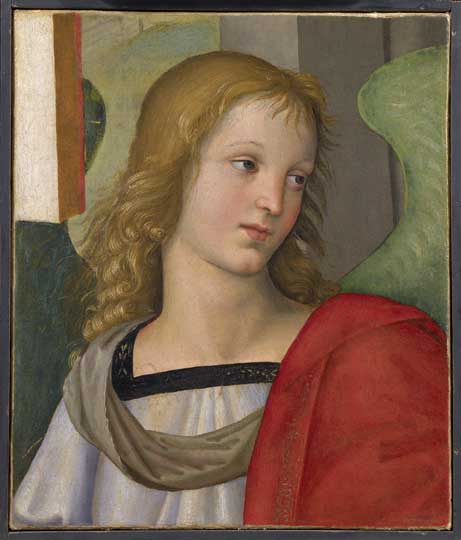 |
| Fragment of Raphael's Baronci Altarpiece from the Brescia |
Like all of the exhibitions of Renaissance
masterpieces that I see in Paris, my first reaction to the Pérugin, Maître de Raphael exhibition at the Musée Jacquemart-André
was wonder. I was amazed at the sight of all these priceless paintings in one
small space. Given all the difficulties of negotiating the loans, transporting,
handling of these fragile paintings, most of which look as though they just
left the artist’s studio because they are so clean and vivid, and because most Renaissance
masterpieces just don’t travel, seeing them together in this exhibition is a
must. In
addition, some of these works are being shown in France for the first time, and
all of them are superbly presented in the intimate of the space of the Jacquemart-André.
In fact, one of the real treats here is the possibility to move up close to
these treasures and see each brushstroke as though we are watching it being
painted.
 |
| Raphael, Predellas from the Fano and Oddi altarpieces Vatican Museums |
My favourite room was towards the end with
the three predella panels, including those from the Fano, the Oddi altarpieces from
the Vatican Museums and the two Tondos from Nantes. For me, the predellas are
the most intimate of Raphael’s work, painted with the labour of love, not always
as important as the main altar piece because they were not necessarily going to
be looked at, even seen, by most congregation members. Because traditionally
the predella was not a part of the main commission, artists freely explored
their talents in such panels. and therefore, filled them with a delicacy and
intimacy that isn’t apparent in the larger pieces. The opportunity to be up
close to the predellas is once in a lifetime – every tiny gesture, every
blemish of the skin is so delicately painted and placed and as I peered into
the strains of the colours, I thought I saw Raphael’s hand moving across the
panels. In these, the luminescent blues, reds, the opalescent skin, the
complicated folds of fabric, all of the features that were signature of both
Raphael and Perugino’s work, and indeed, of the Renaissance more generally, are
heightened by the size, the delicacy of these narratives. We see a head turn, a surprised expression, a
mule in repose, all of which are so delicately painted, it is as if they make
up a private world, into which we are invited to all.
 |
| Fragment of the Baronci Altarpiece by Raphael in the Louvre |
The four surviving pieces of Raphael’s
Baronci Altarpiece are also brought together here and are resplendent. The
Louvre’s angel is also on display here, with its wonderful story of being
discovered following a conversation in a taxi in Strasbourg with one of the
curators from the Louvre. The angel from the Brescia is more beautiful though,
reminding of the Madonnas in deep reflection painted in previous years, also on
display in an earlier room. The sketches of the entire altarpiece from Lille
accompany the four surviving fragments to give the overall arrangement, and
also indicating that the entire piece was Raphael’s creation.
 |
| Perugino, Don Baldassare di Antonio di Angelo. c. 1499 Galleria degli Uffizi, Firenze |
Two monks from the Uffizi, who were once
placed at the corners of an altarpiece are divine for their simplicity of
execution. Their heads look up in veneration to, presumably, Christ on the
cross. The tender and rich Saint Jerome from the Kunsthistorisches Museum in
Vienna is so sensuous that again, it’s not possible to resist his intimate
world. What makes him special is his pure white dress against the dense
landscape of the desert, foregrounding his figure as well as his purpose.
 |
| Perugino, Saint Sebastian, c. 1500 Louvre |
Perugino’s most appealing characters are
deep in reflection; even Saint Sebastian, his body pierced with arrows seems to
be transcending the pain he must be feeling, still alive, to fall into deep
reflection. These figures are dreamy and mystical, yet lifelike thanks to the
freshness of their skin, the delicacy of their expressions. Still, the best
part of this exhibition is being up close, sharing the same air as these 500
year old treasures. Once inside and in the sway of the skin and fabrics of the
paintings, the veracity or otherwise of the claim that Perugino was Raphael’s
master, ceases to matter.
No comments:
Post a Comment